Mike Vardy's Blog, page 84
August 26, 2015
How To Use Multiple Task Managers
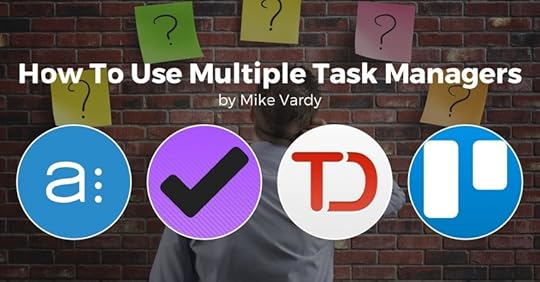
While it is ideal to have one task management solution on an ongoing basis, for some of us that just isn’t a reality.
Maybe it’s because you have to use a specific app for work and you don’t want to use it for activities outside of work. Perhaps others on your team use different tools that you don’t want to use. Maybe the tool you use doesn’t allow for collaborative task management but has an outstanding feature set that is very tough to beat – such as OmniFocus. Just because you have to have to look for tasks in multiple places doesn’t mean that you can’t be organized about it. (In fact, it would be somewhat ironic if you weren’t.)
There’s a simple trick to allow you to use as many task management applications as you want. While this trick isn’t automatic and requires intentionality to work, it does allow you to have the triggers you need to move adaptly from one tool to the next.
All you need to do is assign an identifier to each task related to the task manager that you need to use to complete it.
Essentially, you are creating a resource-based mode in which you assign to every task app that you need to use.
Here’s an example from my own workflow.
My podcast producer does not like to use Todoist or Asana – he is a Trello guy. And that’s fine. There are a lot of things I really like about Trello, but I can’t see myself using it as my primary task manager. It doesn’t fit how my mind operates. But he’s the producer, and I want to make sure that his workflow is not restricted or contains friction.
I created a mode (in Todoist this would be called a label, in Asana it would be called a tag) called “Trello”. Every task that I placed into Todoist that is related to the podcast gets assigned that label/mode. That way whenever I look at the Trello label/mode, I can quickly recognize that I need to either transfer the task there to Trello, deal with the task in Trello, or otherwise spend time on the task – and related ones – in Trello.
(As a matter of fact, the only task I have in Todoist about the podcast is “Review Productivityist Podcast Production workflow” on a repeating basis – as seen in the image below. It’s tagged with the label “Trello” so that way I know I have to be there, and in case other tasks show up I know that that label will lead me to where I ultimately need to go.)

Another example would be how for Productivityist I use Asana for team-based tasks. We are still in the process of migrating more tasks over there because we have a lot going on these days, but not everybody I work with uses Asana as their primary task management solution. In fact, the team has a wide variety of tools that they use. Lee Garrett uses OmniFocus. As previously mentioned, podcast producer John Poelstra uses Trello. Dave Caolo uses Todoist – much like I do. And I don’t even know what Jim Woods, Productivityist blog editor, uses.
Nevertheless, everything that we need to do as a team lives in Asana and progress is communicated via Slack. (I’d be remiss if I didn’t mention that I think that Slack is our most powerful productivity tool as it allows us to work with different task managers and still keep communication flowing as we move Productivityist tasks and projects in the right direction.)
Since most Productivityist tasks are housed in Asana and I use Todoist more than any other task app, what label do you think that I have in there that propels me to spend time in Asana? You guessed it: an “Asana” label.
The great thing about having these labels listed in Todoist is that I classify these as modes. So when I’m in Trello Mode, I know I’m working on the podcast. In fact, I’m likely to start using Trello for any type of video work we are doing because it really is well suited for that type of creative work. Who knows? It might be even the best suited for all content. Based on my experience with the Trello app – with the appropriate Trello label – I realize it could be the ideal tool for some aspects of content management. If I decide to make this transition, with the use of labels it will be very straightforward and simple.
I can easily shift in and out of Trello Mode and in and out of Asana Mode as needed because I’ve created a strong enough trigger and connection with the task manager I use for everything else in my life, Todoist.
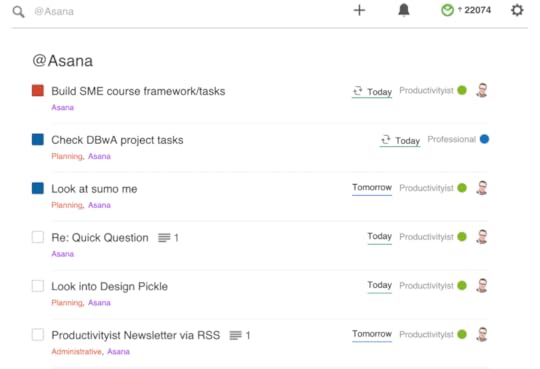
But this trick doesn’t need to only apply to task management solutions either.
I have an Evernote label, a Slack label, and an Email label (some people actually have a Gmail label and an Outlook label because one of them is for personal email and the other is for work email). Again, I identify these labels as “modes” so when I am going into Email Mode, I just click on that label and see everything that I need to do related to email. I would see the same thing if I clicked on Evernote in terms of what I need to do inside of Evernote and the same goes for Slack. (Actually, because we use Slack as our primary communication tool for Productivityist, the label for that has almost become obsolete. If anything, my label/mode “Communication” now houses anything that can be sent by me via Slack to members of the team.)
Now I don’t have a Todoist Mode listed in Trello or Asana because Todoist is where I spend most of my time. It is my “go to” task management application of choice. But if I wanted to shift to any other option, I would simply use a Todoist label to slowly move things out of Todoist and into whatever new option I select. This might be helpful for those who want to make a change to a new task management application, whether they are doing so by choice or – in the case of when their task management system/solution is closing up shop – by force.
Again, if you don’t need to use multiple task management applications, then you should avoid doing so. You don’t want to get caught fiddling with tools instead of using them; this often happens when you have multiple task managers going for no apparent reason. But if you do need to use more than one task management solution, the simple trick of creating modes (by using labels, tags, contexts, etc.) that are associated with those apps can go along way in fostering a healthy and effective relationship with your to do list…no matter where they reside.
To learn more about mode-based work and how you can use my productivity approach (The NOW Year Method) with ANY task manager, check out my Beyond Productivity virtual workshop. It’s specially priced until September 1st, so give it a look today!
The post How To Use Multiple Task Managers appeared first on Productivityist.









August 24, 2015
5 Ways I Read More Than 50 Books Last Year

Everyone wants to read more books, but we don’t spend the time required to do so. Reading is difficult in an environment based on feed refreshes and new blog posts.
It’s a noisy world, and reading just doesn’t fit in that well.
Or does it?
In many ways, reading is like a home-cooked meal compared to the fast food diet of instant information found on your screen.
When you create a good menu you need to plan for it, acquire it, prepare it and then digest it.
Reading is no different. It is food for your mind.
For a long time, I used to read a book a month. Now I read about a book a week.
What changed?
Here are five ways I found to read more books:
#1 Have a book buffet. I always have more books to read than I do read. I visit the library and borrow anything that looks unique. I add books to my Amazon wishlist that might be good.
When I tell people how much I read, their response is often, “Yeah, I need to find a good book.”
But there are so many great books out there to read:
What happens when the best deep sea divers in the world find a sunken U-boat off the New Jersey shore? There’s a book about it.
What happens when a private company stages a coup, complete with an army of mercenaries, all for the control of a single fruit in Central America? There’s a book about it.
What happens with a fugitive flees England, makes it halfway across the Atlantic but is captured all because radio waves were finally harnessed for communication? There’s a book about it.
Each of those books were ones that I found because someone suggested them. I never would have thought, “I need to find a good book,” and stumbled on one of them.
With this mindset, I ordered a copy of Alexander the Great and the Logistics of the Macedonian Army. It was fantastic, a fantastic bore. I tried to read it, but just couldn’t. I gave up on it. Which brings me to number two.
#2 Go ahead and quit a book. Don’t be afraid to stop reading a book. When you go to a buffet, you don’t feel like you have to eat everything, so apply this same approach to your book buffet. Some books are bad, some you just aren’t ready for, some won’t make sense. If you started Lord of the Rings with the third book and wondered why the author kept writing about a “white” wizard, you missed something, right?
This can be hard because we are wired to finish things. It’s why you clean your plate. It’s why we rationalize choices by saying, “we’ve come this far, we might as well finish.” Don’t read a book unless you are excited to read a book.
One of my favorite books is Nassim Taleb’s Antifragile, but I failed to read it the first three times. I had to listen to the audiobook first. Then I read a book related to it. Then I was finally able to finish it. During the first few attempts I wasn’t excited for the book; on the third attempt I was.
And I have a confession, I’ve never finished a single Seth Godin book. I’ve tried, but they aren’t for me. It doesn’t matter that other people love his books, it’s not a good fit for me.
#3 Don’t care what other people think. After college, I thought that knowledge in life was like a giant Lego project. Each time you learned something you added a block to your structure of knowledge. In my twenties, I realized this wasn’t the case. My Lego architecture of Greek history looks more like the current ruins, I know almost nothing. At first I was embarrassed. Guess what, a lot of people are like this.
I had forgotten the specific years of World War II until I read a book about it. That’s alright. People who know about a specific field, whether it’s history, productivity, or medicine are all people we can learn from. They are kindred spirits of learning who just happen to be further up the trail than you. Those people won’t embarrass you for what you don’t know. Those are all people who’ve been able to read more than you, in part because they’ve created good reading environments.
#4 Surround yourself with readers who are reading. I’m in some great book clubs with people like Jamie Rubin, Ryan Holiday, and James Altucher. But none of them know it. I follow them all online and as they share the books they’ve read, I read those books too. I also follow other people that read a lot. This inspires me. It reminds me that the people I admire are all readers and that I should be a reader too.
Shane Parrish at Farnam Street, Maria Popova at Brain Pickings, and the many guests at 27 Good Things all remind me of the value of reading. This has given me the social influence of a book club.
#5 Make reading as easy as possible. Reading in an environment of noise is hard. Would you read at a birthday party? Of course not. But our normal lives can be just as busy. So what did I do?
For me, to read more I had to create more moments that made it easier to read.
When I sit down on the couch, I make sure I sit down with a book. I don’t always read it, but it’s there.
I deleted Facebook from my phone. The notifications were like a gateway drug. Once I was in the app I was too tempted to scroll and refresh the feed.
I moved Twitter off my homescreen. Like Facebook I got in the cycle of scroll-refresh. I also learned that after a long-weekend vacation, I could miss what happened on Twitter and not miss much.
I limit when my emails to arrive at 9:30 and 4:00 thanks to Inbox Pause. That I know I’ll deal with email then makes it easier to stay out of my inbox.
Each of these small actions makes it easier to read.
Each book I read builds on a last book. If I learn about some aspect of psychology, I start to see it in non-psychology books. If I read about something that takes place in the 1940’s it enriches each other book that takes place then.
Reading isn’t easy. Especially when barriers like not knowing what to read or feeling dumb because you don’t know something.
Reading is absolutely worth it. Outside of the people in my life, it’s the most satisfying thing that I do. If you want to read more and are looking for a source of suggestions, check out my reading email list. It’s a free, monthly list of the books I read.
The post 5 Ways I Read More Than 50 Books Last Year appeared first on Productivityist.









August 21, 2015
Win On The Weekends By Losing Football

Recently, Mike wrote a post titled Throw The Deep Ball where he wrote about the forward pass and how sometimes we need to take risks and go for big gains rather than small improvements. That works well for Mike, but I wanted to switch to the other side of the ball and tell you why I disagree.
He’s right that the National Football League season is just around the corner, but I’m no fan of the sport. I used to be. I would sit around for two straight days – Saturday and Sunday – and do nothing but watch football (and eat, people always eat or drink while they watch). Then one day I realized that game days consumed too many beautiful days. One day, I got up and turned off the television. Little did I know that would change my life.
The next season our daughter was born and that was the retirement of my football career (as a fan). Honestly, it couldn’t have ended better.
In all those years as an observer of football, I learned a few things. I learned about the value of the deep ball but also of good defense. The most popular of the different defenses is the “cover-2.”
This defense is situated so that there are two players at the very back whose job it is to not let anybody behind them. On rare occasions they pivot from this, but not often. The philosophy of this defense is bend-but-don’t-break.
The other team can wrack up small gains here or there but they won’t be able to pick up large chunks. Strategically it means the offense has to put together a longer sequences of successful plays without miscue to score points.
Life – as Mike wrote – is no different.
We should have a plan in place that allows for the little things to happen in life, because they don’t do us harm. Our business can survive slow days, but not barren months. Our productivity can flirt with social media, but not for all day. Our careers can be delayed longer than we’d like, but not completely derailed.
For me, it was the removal of football that helped my productivity the most.
Did you know the average professional football game lasts 3 hours and 12 minutes, but the time when the ball is actually in play a mere 11 minutes? Even if you love to watch football, this is a good argument for recording it and fastforwarding through some of the commercials, right?
I started to use my time better on Saturdays and Sundays. I read more, wrote more, and spent more time with my family. It didn’t matter if I snuck off to work on a weekend afternoon because the rest of the weekend could be family time. When I gave up football, I installed a better time management defense.
It is important to use a good plan that keeps you focused – either The NOW Year Formula or another one that works for you – so you can move forward with the confidence that we can bend but not break and win in the end.
How do you manage the things that could be big distractions? Are you a bend-but-don’t-break type like I am with little things or are you an absolutist who doesn’t give an inch like I am about football?
The post Win On The Weekends By Losing Football appeared first on Productivityist.









August 20, 2015
The Productivityist Podcast 53: Making Teamwork Work with Sebastian Klein of Blinkist
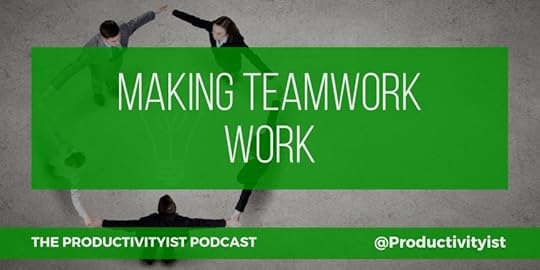
Being productive on your own can be a challenge with everything we face today but being productive as a team can be even more daunting – especially when they are spread out across the globe.
On this episode of the podcast, I chat with Sebastian Klein of Blinkist about how his team has adopted (and adapted) Holacracy as a productivity approach to make teamwork, well, work.
Links
Sebastian Klein (@kl1eb) | Twitter
Holacracy – A complete system for self-organization
Free e-Book on Holacracy: Blinkracy
A Look At Meetings | The Productivityist Podcast
Support The Productivityist Podcast
You can support The Productivityist Podcast in a number of ways:
Become a member of The Productivityist Podcast Patreon community and receive additional exclusive content with every episode – and get two bonus episodes every week!
Subscribe in iTunes and then leave a rating and review to let me know what you think about the show.
Subscribe with Stitcher.
Subscribe via RSS.
The Productivityist Podcast is released weekly, so keep your eyes here on the blog (or subscribe to get it directly using one of the methods mentioned above) to make sure that you don’t miss a single episode!
The post The Productivityist Podcast 53: Making Teamwork Work with Sebastian Klein of Blinkist appeared first on Productivityist.









August 19, 2015
A Look At 3 Great Alternatives To IQTell
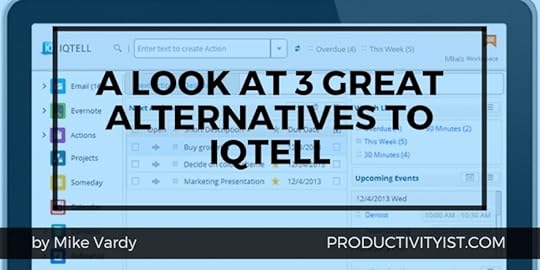
All-in-one task management solution IQTell is shutting its doors (more specific details here) and now a loyal user base is looking for other options to keep tabs on everything they’ve got on the go. Ran Flam, CEO of IQTell, stated in the announcement of the closure the following as one of the reasons for the shutdown:
“This space has become filled with much simpler solutions that prevented the growth we were expecting for IQTell.”
I’ve always been hesitant to use a tool that groups everything into one place like IQTell. I feel an all-in-one solution is not ideal for me as I often want flexibility for some of the tasks. I never spent a ton of time in IQTell, but I did find its initial interface a bit unwieldy to navigate.
If you are currently using IQTell (or were considering it), here are three of the best alternatives I’ve found. None of them will have everything that IQTell offered – and that isn’t necessarily a bad thing – but these options have the ability to scale as well as IQTell did. Each option also gives users simplicity, which is always important.
1. Asana
Asana has been around for years and scales incredibly well. While IQTell allows for direct email integration in its service, Asana does all it can to eliminate email from the equation (even though you can have tasks emailed to you and you can email tasks to Asana Workspaces). With collaborative features, tagging, project dashboards, and plenty of other features to offer, Asana is a great option to consider. If you’re looking to move to something that can handle a lot of tasks and projects – look no further. Best of all, it’s free for 15 users or less.
I’ve co-authored a book with Jeremy Roberts called Do Better With Asana that can help you take your Asana experience to greater heights. Click here to learn more about Do Better With Asana.
2. Todoist
If you’re looking for clean and simple task management with enough power to scale both personally and collaboratively, then you’ll want to check out Todoist. It has an Outlook extension (something IQTell offered), allows for emailing directly into Projects, and has exceptional filtering with Boolean queries and more. It is available for more platforms than any other options out there and has a large user base that offers help within the forums and a vibrant Google+ community. It’s not all that expensive either, costing only $29/year for the feature-rich premium version.
Productivityist has an extensive archive of posts on Todoist. You can view these archives and start learning more about it by clicking here.
3. Nozbe
Nozbe is a fantastic task management solution that works for teams and individuals alike. It integrates strongly with Evernote – much like IQTell – and has a clean interface to boot. It’s used by a myriad of people, and can count Michael Hyatt (a popular thought leader and writer) among its users. After all these years, Nozbe is still his favourite task management system. The founder of Nozbe is well-respected in the productivity space and has been committed to building it into a reliable and versatile productivity tool. While Nozbe doesn’t offer all that IQTell did, it offers a clean and powerful user experience that is definitely worth exploring.
Still not sure what is the right fit for you? I suggest you watch this free webinar I did with Steve Dotto called Choosing The Perfect Task Manager. In the webinar, I go over how I score four options – the aforementioned Asana and Todoist along with Trello and Wunderlist – in terms of simplicity and scalability. You can check out the webinar by clicking here.
The post A Look At 3 Great Alternatives To IQTell appeared first on Productivityist.









August 17, 2015
How to Take OmniFocus to the Next Level
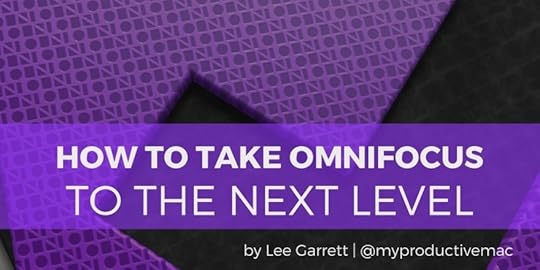
I had the privilege of reviewing Creating Flow with OmniFocus 2 by Kourosh Dini and I took many positive influences from it. In fact, the mainstay of my current setup is down to the advice and recommendations that are laid out in the book.
This post is being created as a direct result of the book. Now I am able to compartmentalize certain areas of my life and block out all of the ‘stuff’ that doesn’t currently need my attention. I’ve developed a writing habit which allows me to comfortably produce over 1,000 words per day and I know exactly when they are going to be written.
I’m comfortable with the decisions that I’m making and the actions that I am not currently taking–mainly because of this book.
I’m not going to give you a detailed summary of the contents. It is so valuable I’d recommend buying the book in order to fully embrace the philosophies that Kourosh suggests. Instead of a summary I’d like to discuss one specific aspect of my setup which has been heavily influenced by Creating Flow with OmniFocus 2 and that is Dashboard Perspectives.
If you are still reading this post, then I’m going to assume that you are an OmniFocus user and understand the concept of Perspectives. They are great because in order to reach our productivity potential, we need to be able to focus solely on the tasks that are important and available now whilst blocking out the noise that can siphon our attention away from the actions that really matter now.
To this end, the most used Perspective I have configured at the moment is, without doubt, the Dashboard perspective (others call this the Today perspective. I’m very simple. I just call it – Dashboard. In fact, I didn’t realise how simple I was until I typed that line!
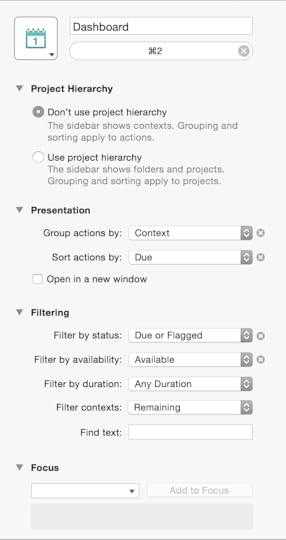
The configuration for the Dashboard really is pretty basic. I don’t follow a project hierarchy, instead using the context view. The reasons for this are two-fold. One, I use this perspective on both my iPad and iPhone and perspectives based on the project hierarchy will not be available for view on these devices. Secondly, I like to be able to look at the day’s tasks organized by the different modes I will find myself in. What needs doing on my laptop at the office? Which calls do I need to make? When I meet up with my boss later, what key points do I need to discuss with him? This is all going to be displayed within my Dashboard perspective.
The options in the Presentation section differ dependent on the hierarchy you have decided to base your perspective on. By not using the project hierarchy, you have the ability to be able to group by Contexts I also sort them by their Due date.
The key configuration that supports the use case of the Dashboard perspective comes within the Filtering section. By setting the Filter by Status option to Due Or Flagged, only tasks that have a Due date of today (or has an upcoming due date, dependent on how you have configured this in Preferences), or tasks that are flagged, are present. This allows you to have a snapshot view of all of the key tasks you either have to, or would strongly like to, achieve today. All of the other cruft is gone.
There are many ways that you can utilize this to fit your own workflow and style of doing things. Personally, I populate my dashboard with the following, however there is no right or wrong way to do it, only your way that works for you.
When I complete my review of how the day has gone (I use Day One), I follow up with an OmniFocus review. I look at my Forecast to see what I have being released from their Defer status over the following days, as well as upcoming due tasks. If I want to clear one of these Due tasks early, I will flag it so it appears in the Dashboard perspective. I will then move to my Quarterly Goal perspective. This is a custom perspective that I created which lists the five primary goals I set myself for the quarter, alongside 3 secondary goals. Each of these goals has a link to a project within OmniFocus stored in the Notes field. I will decide which goal I have capacity to work towards, click the relevant link in the Notes field and flag either the project (if there are several short tasks that can be done) or the first available task itself. This then appears in my Dashboard perspective.
All maintenance tasks that really should be done at regular intervals appears as Flagged tasks, with repeating Defer dates (unless of course it is mission critical maintenance that has to happen on a certain date. However I really don’t have many of these). Most of my household chores appear and are subsequently closed down on Saturday. Electronic device maintenance on a Sunday as well as the essential OmniFocus Review (this is a DUE tasks on a Sunday. If I don’t do my review, I don’t function. It’s also scheduled into my Calendar).
There is nothing stopping you from taking this to the next level and having Dashboards for individual contexts. For example, I have a Home Dashboard which has exactly the same configuration as the regular Dashboard, but it focuses solely on a folder I have called Home. This houses all of my home projects and maintenance tasks. I have a Tech Dashboard for all of my technology maintenance tasks and projects, as well as a Study one for all of the studying and reading I am currently undertaking for both my career and personal improvement.
It should be noted that you need to have the Pro version of OmniFocus in order to fully leverage custom perspectives. I find this to be money very well spent, however because I am able to power through my tasks really quickly through the day without having to wade through a running list of tasks that don’t really warrant my attention. I can plan my days effectively, ensuring the core tasks, or MIT’s or knocked out as soon as possible.
Dashboards are just the tip of the iceberg in Creating Flow with OmniFocus. There are many hints and tips for how to deal with recurring tasks, link to external applications like OmniOutliner (something I am leveraging a lot now that the iOS app is universal), setup more custom perspectives. It really is a good read.
So if you are an OmniFocus user who doesn’t currently utilize some form of Today Dashboard, I urge you to set one up and just go play with it, see how it works for you and what you need to do to make it work for you. You’ll notice the change in your output very quickly.
The post How to Take OmniFocus to the Next Level appeared first on Productivityist.









August 14, 2015
Triggers: How to Start Moving
They can lead you do something drastic, and in a lot of cases there’s no turning back — at least not easily. Triggers can often be ignored, and I’ve done my share of ignoring. One of the triggers that I listened to that I didn’t ignore was a pretty drastic one: when I left my steady day job a few years back to pursue something else — something less stable.
The thing about triggers is that when you start listening to them you get better at realizing their worth. You get better at predicting (or presuming, rather) part of the outcomes of following through with them. You get better at knowing what you’ll have to do to get closer to the desired outcome and how you can allay the risks involved with that hard work.
Here are some of the triggers I’ve acted on. The list contains a mixture of high and low impact triggers, but it is still an effective list worth examining:
Sticking with “Night Owlism” over getting up early
Giving my site an ongoing facelift while still producing content for it
Adjusting to an unconventional work week that best suits my workflow
Moving to Asana over OmniFocus
Moving away from Google
Teaching myself Markdown
Upping my accountability in my own work by writing a contentious post about Lifehacker’s content quality
The last one was a real tough one, because I basically ensured that Lifehack needed to steer clear of that road as long as I was affiliated with the site. I still am, so I’ve put my feet to the fire on that one. That means more work, but I knew I had to get it out there so I went there anyway.
Yes, triggers can be dangerous. But not listening to them can be just as dangerous. If you know you’ve ignored them before, listen to some of the ones with the smaller risks involved and work your way up. It’s important to remember that guns use triggers to fire bullets, but they also use them to start races — from sprints to marathons.
Triggers can make you stop going or just go forward. What triggers don’t do is keep you standing still. And we all know how much you can get done by just doing that.
On that note…BANG!
Wired to be a night owl like me? Stop fighting your body clock and start embracing how you work best with The Night Owl Action Plan. Get the ebook, audio program, and quickstart PDF for only $10 today by clicking here.
Photo credit: Solo (CC BY-NC-SA 2.0)
The post Triggers: How to Start Moving appeared first on Productivityist.









Tweaking vs. Fiddling

I’m not a morning person. I tend to do my best work in the wee hours hours of the late evening, where I find that my creative juices are flowing. So I generally stay up late and get up late for that reason.
I’m also not working so much as an individual right now either. I am working more collaboratively these days, as part of a larger team where things need to be tracked across the miles. So I generally use Asana now rather than OmniFocus for that reason.
I’ve not been working out too much lately. I get caught up in work, family and other aspects of my “life” and exercise has fallen by the wayside. So I generally don’t work out as much as I used to.
As of late, “generally” hasn’t been applying to my life all that much. So I’m doing some general tweaking.
This isn’t the same as fiddling, mind you. I have my tools in place and they are working for me. Fiddling generally involves avoiding the things you need to do rather than work towards making those things happen. You wind up getting caught up – and have to play catch up as a result.
Tweaking is making changes that are necessary in order to better optimize your situation – in this case, my ability to shift between work mode and life mode. Tweaking are changes for the sake of progress; fiddling are changes for the sake of change.
Big difference.
So while I’m not fighting my body clock, I’m shifting it. I am going to get up at 7 am and hit the sack at midnight. That means I am shifting my waking hours an hour or two earlier, but not in a drastic way. It’s a tweak that needs to be done so I can help my wife have a better start to her day and allows me to have more time with the kids before they head off for their day.
As for my task management system, I’m spending more time working in Asana with team-based stuff and I’m keeping a close eye on OmniFocus as it still holds some of my longer-term individual projects. As I get more proficient with Asana, that may change. But I’m not going to spend an inordinate amount of my time on that right now. i’m simply going to learn as I go, with a deeper dive to happen somewhere down the line. The tweaking takes place in how I use Asana, rather than how I manage my tasks and projects. Fiddling isn’t an option, nor do I want it to be.
By tweaking my waking hours, I can tweak my exercise habit (or lack thereof). I’m going to get back to running – starting today. Whether I go with my old Couch 2 5K routine or dive into the Rebel Running Guide by my pal Steve Kamb over at NerdFitness, Im going for a run today. This simple tweak involves a three-day-a-week commitment, and I’m worth it. So is my family.
By tweaking the right things at the right time, they can all feed each other in a way that makes you more efficient and effective. Proper tweaking makes things better, both directly and indirectly. There’s no such thing as proper fiddling, but it sure can impact things both directly and indirectly.
So…do you tweak or do you fiddle?
Are you a night owl and want to level up your late night productivity? The Night Owl Action Plan will help you do just that. Click here to purchase this combination ebook, guided audio program, and quickstart PDF for just $10 now!
Photo credit: Michael Kenny (CC BY-NC-SA 2.0)
The post Tweaking vs. Fiddling appeared first on Productivityist.









Comments[…] and effective ways to do my work. Some may call that ... by The Search for My New Email App of Choice: Notify[…] on other projects as result. I did reflect on where I was ... by Sometimes You Just Have to Go Home[…] to make a decision: to give in to my impending sickness ... by Sometimes You Have to Give In@mikevardyIf you don't, you'll have to answer to me.
August 13, 2015
The Productivityist Podcast 52: Everything Evernote with Andrew Sinkov
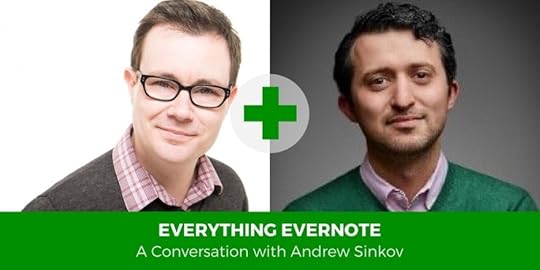
Want to learn more about what makes Evernote tick? In this episode of The Productivityist Podcast, I have an in-depth conversation with Andrew Sinkov, Vice President of Marketing and Brand at Evernote. We talk about where Evernote has been, where it’s headed, and we even dive into some of the decisions the company has made (and the markets it has entered) over the years.
You can listen to the podcast directly by using the player below.
Links
How Tim Ferriss used Evernote to write The 4-Hour Body | Evernote Blog
How I Use Evernote for Beer Cellaring | Productivityist
The Night Owl Action Plan | Mike Vardy
Evernote And The 100 Year Business Plan: Why Users Love It And Funders Hated It | Forbes
andrew sinkov (@sinkov) | Twitter
Support The Productivityist Podcast
You can support The Productivityist Podcast in a number of ways:
Become a member of The Productivityist Podcast Patreon community and receive additional exclusive content with every episode – and get two bonus episodes every week!
Subscribe in iTunes and then leave a rating and review to let me know what you think about the show.
Subscribe with Stitcher.
Subscribe via RSS.
The Productivityist Podcast is released weekly, so keep your eyes here on the blog (or subscribe to get it directly using one of the methods mentioned above) to make sure that you don’t miss a single episode!
The post The Productivityist Podcast 52: Everything Evernote with Andrew Sinkov appeared first on Productivityist.









August 12, 2015
Throw The Deep Ball

The National Football League season is just around the corner, and I’m a big fan of the sport. I order the NFL Sunday Ticket so I can watch every Cincinnati Bengals game. I take part in fantasy football. I even shift my work schedule around so that I can watch football, spend time with my family, and still get plenty of work done from September through February.
Yep. I love football.
Football is as strategic as it can be brutal. It features a lot of stop and go, and a lot of guessing in order to make sure the offense can move forward or – if you’re on the defensive side of the ball – barely move at all.
The NFL has largely been built on the running game in the past, with the passing game being used more and more in recent years. In fact, the forward pass has been around for less than 100 years (American football has been around since 1869) and was not exactly welcomed with open arms when it was first introduced to the game.
Why was that?
Well, teams initially didn’t know how to defend it. That meant huge gains for the offense and more scoring. Over time, defenses adjusted and the risk of the forward pass became greater as the secondary defensive players (generally the ones who covers the eligible receivers of the football) were able to catch the ball instead – or intercept the passes.
The forward pass can be risky, especially the farther down the field it is flung. There is more time for the defense to adjust. The quarterback’s accuracy can be compromised the deeper he throws it. The chance of something going wrong is greater because the difference between where the ball was and where it is set to be is greater.
But sometimes, in order to catch the defense off guard or because they’ve played the run, you have to throw the deep ball…despite all of the risks involved.
Life is no different.
Sometimes you need to play it safe and make short gains. But sometimes you need to go deep. You need to figure out if you can make that big play happen. And if you have the right pieces in place – the right approach, the right mindset, the right tools – you’ll have a better chance of reaping the rewards of going deep.
If you’ve got the right approach in place – either The NOW Year Formula or another one that works for you – then don’t be afraid to throw the deep ball every once in a while. The results – no matter what they are – will be worth receiving.
The post Throw The Deep Ball appeared first on Productivityist.













